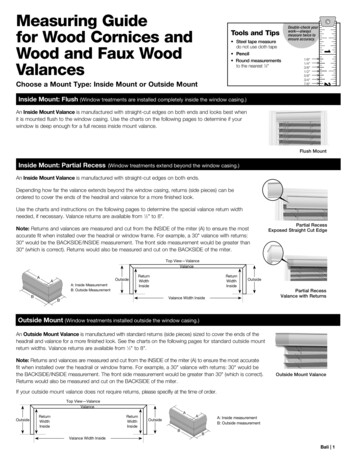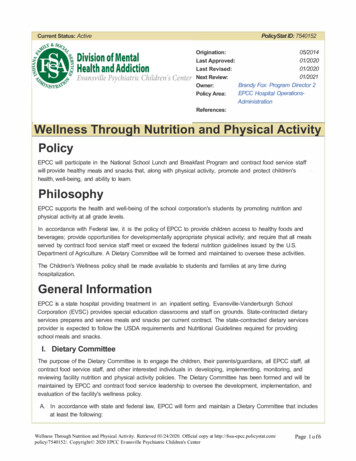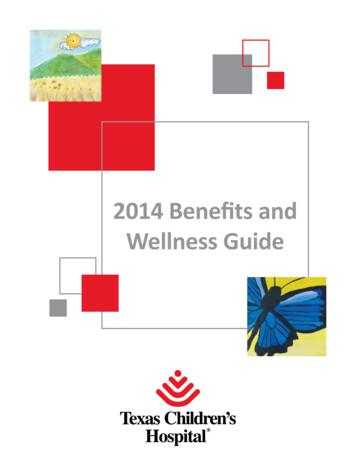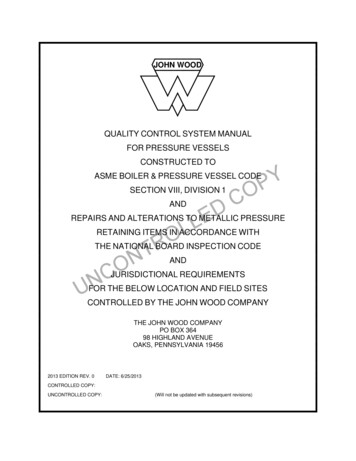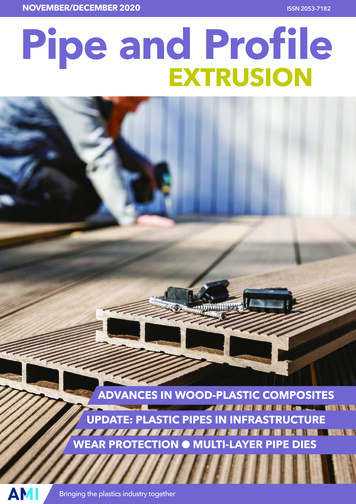
Transcription
www.bregroup.comWood and WellnessDr Ed Suttie, BRE, United Kingdom
BREEAMOver 561,000 buildings certified inmore than 70 countries.www.breeam.com
CHARACTERISTICS LINKED TO COMFORTTemperatureHumidityAcousticsLightVOC sColoursSurfacesLuukku House, Aalto University
– Social sustainability
Wellness1
Health & Wellbeing Mental Health – how we think, feeland cope with daily life Physical Health – absence ofdisease and optimal function ofbody Social Health – how we react toother individuals and groups andhow they react to us
Why now?– WHO forecast stress related illness primary cause of sickness by 2020– In 2015/16 stress accounted for 37% of all work related ill health cases and 45% of allworking days lost due to ill health.– WHO Common mental conditions such as depressive and anxiety disorders in the workingpopulation accounts in the European Region for costs of 140 billion pa.– Urbanisation in Europe 74% 2018 – up from 51% in 1950– Technology impacts 93% of UK adults have smart technology and over 30% admit tochecking smart phones in the middle of the night– 13% of households within the EU-28 in 2013 are composed of a single person aged 65 orover– We spend 90% of our time indoors - losing our connection to nature– Think of a place where you feel relaxed and inspired?
Activity
Image Courtesy of World Green Building CouncilHealth, Wellbeing & Productivity in Offices report
森林浴– Picture of forests and woodlands
The Biophilic Office project2
What defines a great indoor environment?
Biophilia– Biophilia hypothesis, idea that humans possess an innate tendency to seekconnections with nature and other forms of life.– The psychoanalyst Erich Fromm in The Anatomy of Human Destructiveness(1973)– Harvard Professor of Biology Edward O. Wilson in his work Biophilia (1984),proposedOur genetic connection to nature
Key constructs of Biophilic designContact with natureWater, trees, plants, lightNatural analoguesEvoking a sense of natureHuman spatial responseEnergising, relaxing, restorative
14 Patterns of Biophilic DesignDirect ConnectionIndirect – natural analogues1. Visual Connection with Nature8. Biomorphic forms & patterns2. Non-Visual Connection with Nature9. Material connection with nature3. Non-Rhythmic Sensory Stimuli10. Complexity and order4. Thermal & Airflow Variability5. Presence of Water6. Dynamic & Diffuse Light7. Connection with Natural SystemsHuman Spatial response11. Prospect12. Refuge13. Mystery14. Peril
yair
Q-Free office, Trondheim– Noise reduction– Interest– Promote health and creativity
The workplace of the future?
The project Grow and deepen the evidence base for health, wellbeing and productivity impacts ofrestorative office refurbishment
The questions What practical interventions can office owners implement to improvehealth and wellbeing? Can these be quantified as part of the decision making process? Measures of better business outcomes - occupant productivity? Provision of practical guidance to engage refurbishment contractors, realestate owners and designers
The building– 1980s concrete framed office– Civil service cellular offices– ‘Standard’ refurbishment heating,lighting and ventilation strategyand controls
Materials and services inventory
IAQ monitoringContinuous monitoring using Tinytag loggerso Temperature and RHo CO2 levelPeriodic monitoringo Ventilation rate (ACH - using tracer gas)o VOC (total and individual compounds by ISO16000 & 16017 methods)
Assessment of daylight levelsComputer modelling of daylight: Daylight distribution across office space Annual profiles of daylight illuminance at eye level,working plane level and window levelDaylight monitoring: Outdoor level of daylight – roof-mounted light sensor plusinternally mounted power supply and data logger Indoor level of daylight
Assessment of acoustic environmentModelling of acoustic environment: Reverberation timeCharacterising acoustic environment Walk through surveyNoise monitoring: Decibels in office Background External
Biophilic office project: Occupant monitoringPsychology: Questionnaires, tools, cognitive tasks, interviewsPhysiology: Biomarkers, wearablesBusiness “productivity” measures
Proposed Plan Developed with NOVATION
Kellert Area – Integrated DesignCreating An Integrated Biophilic StrategyIn the Kellert area we are focusing on Biophilic design solutions which could beeasily adopted and integrated in the beginning of any refurbishment project.Example Features:Timber clad walls with integrated planting, a “quiet” zone with window seat forrecuperation and new flooring design which mimics patterns found in nature.
Wilson Area – Innovative DesignCreating An Innovative Biophilic StrategyThe Wilson area is being developed with a high level of Biophilic design interventionand innovation. This space is an opportunity to showcase new products, newsystems and innovative design ideas for the ideal workspace.Example Features:Living green walls, timber biomorphic screening, a complete sound scaping systemand water wall, intelligent furniture with integrated heating and cooling.
Project TeamProject Team
Dissemination partners
The biophilic office project– www.bregroup.com/biophilic– LinkedIn Group Biophilic Design: Realising our Need for Natureat Work– 6-7 June 2019 @BRE, Watford UK Wellness and BiophiliaSymposium - Using Nature-Inspired Design to Foster WorkplaceWellness
Wood3
The role of timber in healthy buildings
t
Influences on building occupant health and wellbeingBuilding environmentWoodOccupantIndoor air qualityAcoustic qualityDaylight and lightingHygrothermal massThermal comfortHumidityViews of natureIndirect contact withnatureVisual varietyHaptic qualitiesColourAestheticDesign, layout andergonomicsChoiceEngagementComfortOccupancy level
Research1. Perceptions of wooden surfaces and ‘wood preference’2. Physiological and psychological benefits of wood3. Evidence in practice from around the world
Perceptions of wooden surfaces and‘wood preference’4
Hypothesis 1People have positive attitudes towards wood ininteriors. Wood is commonly perceived as natural,warm and healthy, and is often preferred over othermaterials.
Consumer perceptions of wood– Johnsson (2008) Between wood product study for solid wood, wood-based panels andcomposites. The solid wood samples were most liked by consumers - preferred corecategories were naturalness, smoothness and living impression.– Nyrud and Bringslimark (2010) noted that attributes that can influence aesthetic preferencecorrespond with some of the preferred physical properties of wood, namely complexity,coherence and naturalness.Nyrud, A. Q., & Bringslimark, T. (2010). Is interior wood use psychologically beneficial? A review of psychological responses toward wood. Wood and FiberScience, 42(2), 202–218.Jonsson, O., Lindberg, S., Roos, A., Hugosson, M. and Lindström, M., Consumer perceptions and preferences on solid wood, wood-based panels, andcomposites: a repertory grid study. Wood and Fiber Science 2008; 40(4): 663–678.
Planet Ark Wood Housing Health Humanity– Explores the use of wood in the interior of a building as having clearphysiological and psychological benefits that mimic the effect ofspending time outside in nature.– Feelings of natural warmth and comfort that wood elicits in peoplehave the effect of lowering blood pressure and heart rates, reducingstress and anxiety, increasing positive social interactions andimproving corporate image.– Important for environments in which it is difficult to incorporatenature indoors, such as hospitals where strict health and safetyguidelines may prevent the presence of plantsPlanet Ark, Wood housing health humanity report, 2015, at net Ark, Wood nature inspired design: an update of the Wood: housing, health, humanity report, 2016, ure-inspired-design-report-final.pdf.
Wood preferenceMaterialPerceptionCreates a naturallook and feelCreates a warmand cosyenvironmentVisually appealingFeels nice to touch EnvironmentallyfriendlyRelatively tic141824361471Results of the Planet Ark survey asking how participants perceive different material types (score out of 100)
Wood vs wood-look?– Usually wood is compared to carpets, glass, leather, stone or plastic, but is not compared toa visually similar material such as laminate.– Jiménez (2016) analysed and compared the psychological characteristics related to woodenand laminate materials in interiors . Their results show that wooden floors were evaluated assignificantly better than laminate floors regarding ‘atmosphere’ and ‘values’ and ‘function’.For the criterion ‘health’, a tendency to favour solid wood was found.Jiménez, P., Dunkl, A., Eibel, K., et al., Wood or laminate? Psychological research of customer expectations. Forests 2016; 7(11): 275.
Wood preference in hospital rooms– Nyrud et al. (2014) investigated preferences for wood inpatient rooms– Patients and clinical staff were asked to evaluatecomputer-manipulated images of rooms with differentamounts of wood on surfaces - a room that had no woodpresent, some wood present and a lot of wood present.– The room with some wood present was preferred, thenthe room without any wood and then the room with a lotof wood was liked least.– Suggests a limit to how much wood is preferred.Nyrud, A. Q., Bringslimark, T. and Bysheim, K., Benefits from wood interior in a hospital room: apreference study. Architectural Science Review 2014; 57(2): 125–131, ds/2014/12/Nyrud-et.al pdf.
Wood preference in homes– Rice (2006) demonstrated that the colours and texture of wood elicitfeelings of ‘warmth’, ‘comfort’ and ‘relaxation’ in people.– People’s responses to wood are, for the most part, extremelypositive, with subjects generally showing a strong preference forrooms containing many wood details.– Appears to be a strong belief that the use of wood can help createhealthful environments, and commonly evoked descriptors for woodrooms include ‘warm’, ‘comfortable’, ‘relaxing’, ‘natural’ and ‘inviting’.Rice, J., Kozak, R., Meitner, M. J. and Cohen, D. H., Appearance of wood products and psychological well-being. Woodand Fiber Science 2006; 38(4): 644–659.
Wood preference in living rooms– Sakuragawa (2006) quantified the impact of visual stimulationfrom interior wood finishes on the impression of room interiors,and user feelings– Four types of room interiors with interior wood finishes used indifferent proportions were simulated– In an evaluation of ‘living’, the photograph of a room interiorwithout wooden materials was evaluated as a place that testsubjects did not feel like living in.– The photograph showing wood materials used only as flooringwas evaluated as the place that test subjects most felt like livingin and considered most suitable as a living space. This points tothere being a balance of amount of wood products in interiors.Sakuragawa, S., Change in the impression of rooms with interior wood finishes arranged differently:questionnaire survey with the use of photographs for the analysis of impressions of rooms concerning livingactivities. Journal of Wood Science 2006; 52(4): 290–294.
Wood odour preference– Matsubara (2014) assessed subjective differences inwellbeing in a room equipped with walls of Japanese cedarwood compared to a control room with no wood.– The timber was screened from view and crenelated tomaximise VOC release– Responses of the panellists were significantly differentbetween the two conditions, with a preference for the woodwalled room.Matsubara, E. and Kawai, S., VOCs emitted from Japanese cedar (Cryptomeria japonica) interior wallsinduce physiological relaxation. Building and Environment 2014; 72: 125–130.
Hypothesis 1People have positive attitudes towards wood in interiors.YESThe material wood is natural, warm, healthy, smooth,YESWood materials are often preferred over other materials with test groups inglobal studiesYESWood products in buildings are preferred with limits on the amount in one room
Physiological and psychological benefitsof wood5
Hypothesis 2Wood has a positive impact on human psychologyand physiology.
Healthcare– Ulrich (1984) demonstrated benefits to patients recovering form gall bladdersurgery in rooms with views onto nature:– patients recovered 8.5% faster– the required 22% less medication– patients felt less painUlrich R.S. (1984) View through a window may influence recovery from surgery. science. 1984 Apr 27;224(4647):420-1.
Healthcare– Anme (2012) concluded that wood products improve the quality of life of elderly people inassisted living accommodation (44 elderly people and 30 health and social care professionals).– The results indicate that regular use of wood products (tables, chairs, tableware) significantlyincreased social interactions and harmonious relations, activity levels and mental energy inelderly people.– Thus, wood products appeared to improve the quality of life of elderly people by stimulatingemotional relationships through improved cognitive function. Social interactions that lead toopportunities for self-expression in old people reduce the risk of dementia, a disease thatcurrently affects over 50M people worldwide.Anme, T., Watanabe, T., Tokutake, K., et al., Behavior changes in olderpersons caused by usingwood products in assisted living. Public Health Research 2012; 2(4): 106–109.
Healthcare– Augustin and Fell (2015) considered the impacts of natureviews, plants, natural light and soundscapes on healthcareenvironments. Part of the report looks at wood in healthcareenvironments and provides a comprehensive summary,including self-reported studies by Japanese researchers whoare actively engaged in the field.– In healthcare environments, natural materials and views areassociated with better patient outcomes with respect torecovery times, lower pain perception, and positivedispositions.Augustin, S. and Fell, D., Wood as a restorative material in healthcare environments, version 1.2, FPInnovations, 2015, at f.
Education– In the Hauptschule Haus im Ennstal, Austria students were taught in either a classroomfurnished with floors, ceilings, cupboards and wall panels made of solid wood or aclassroom fitted with a linoleum floor, plasterboard walls and chipboard cupboards.– Kelz (2011) studied this use of wood in classrooms and found that over the course of aschool year pupils’ heart rates significantly decreased in the solid wood classroom butincreased in the control classroom.– Perceived stress from interactions with teachers (e.g. being shouted at, being ignored)decreased significantly over the school year in the solid wood classroom, while it did notchange for pupils in the control classroom.– This study did not find significant differences or changes over timein pupils’ concentration.Kelz, C., Grote, V. and Moser, M. Interior wood use in classrooms reduces pupils’ stress levels, 2011, f.
Offices– The psychophysiological response to wood was studied byFell (2010), specifically the autonomic responses of 119subjects in wood and non-wood offices before, during andafter a stressful mental task– A 2014 study by the University of British Columbia refittedsimilar offices with different materials and measured healthaspects of occupants– As visual wood surfaces in a room increased it loweredsympathetic nervous system activation, which is responsiblefor physiological stress response. Fell confirmed that thissensation of relaxation in the presence of nature is due to areduction in stress reactivity, which is both psychologicallyand physiologically beneficial.Fell, D., Wood in the human environment: restorative properties of wood in the built indoor environment,PhD thesis, University of British Columbia, 2010.
Hypothesis 2Wood has a positive impact on human psychology and physiology.SOMEEducation - promising results from Austria should be replicated with moresubjects and different age groups to build upon this exciting finding.SOMEHealthcare – research in its relative infancy, long-term studies are scarce andinclusion of wider demographics is requiredSOMEOffice - exciting results from Canada should be replicated with more subjectsand different age groupsLIMITEDHomes – little evidence for housing
Evidence in practice from around theworld6
Hypothesis 3Wood is specified for its health and wellbeingqualities.
Wood in HealthcareOne Kids Place children’s treatment center, North Bay, ONCritical Care Tower at Surrey Memorial Hospital, Surrey, BCThunder Bay Regional Health Sciences Centre, Thunder Bay, ONTseshaht Tribal Multiplex & Health Centre, Port Alberni, BCGateway Lodge Complex Care & Assisted Living, Prince George, ood-inHealthcare-Case-Study.pdf.
Wood Housing HealthHumanityDandenong Mental Health CentreMarist College Bendigo, Montagne CentreMelbourne School of DesignThe Village Centre, National Arboretum, CanberraTempe House, Tempe, NSWThe Library at the Dock, Victoria Harbour, MelbournePlanet Ark, Wood housing health humanity report (2015)
Thinkwood casesstudiesThe Herrington Recovery Center, MilwaukeeAnkrom Moisan Architects at 38 es
Inside and outOsteopathie Praktijk steopathie-praktijkroosendaal.
CalmTimber Dentistry, Minoowww.architizer.com/projects/timber-dentistry.
CareHealthcare Centre for Cancer thcare-center-forcancer-patients.
NaturalSkandion Clinic, .
WarmThe Onni Wellbeing Centre, ealth-effectswood-building-material.
Stress freeSchule Ohne Stress, Hauptschule Haus imEnnstalwww.holzfachberater.at/seiten/news.php?m 12&id 2
FocusKnowledge Centre, St. Olavs ledge-centre-st-olavshospital.
AirMedical Care Centre Limay, er-limay.
Sunbeams Music Centre, PenrithDyson Centre for Neonatal Care, BathMaggie’s InvernessThe Living Planet, WokingThe Enterprise Centre, NorwichMaggie’s Oldham
Hypothesis 3Wood is specified for its health and wellbeing qualities.YESLIMITEDWood is specified as a versatile, natural, beautiful materialWood is specified for its health and wellbeing qualities.
Emissions from wood– Nyrud (2012) the use of wooden wall panels in hospital rooms hadno effect on the amount of VOCs in the indoor environment.– Zylkowski and Frihart (2017) recorded α-pinenes as one of thoseVOCs that are part of the naturally present compounds in softwoodslike pine, which give it the familiar pine smell could be a significantsource of natural antioxidant compounds that have beneficial healtheffects.– Naturally occurring VOCs can have positive impacts on humans.Song (2017) found volatile compounds from Himalayan cedarincreased blood oxygen saturation while blood pressure and heartrate all reduced.Nyrud, A. Q., Bringslimark, T. and Englund, F. Wood use in a
The Wilson area is being developed with a high level of Biophilic design intervention and innovation. T
